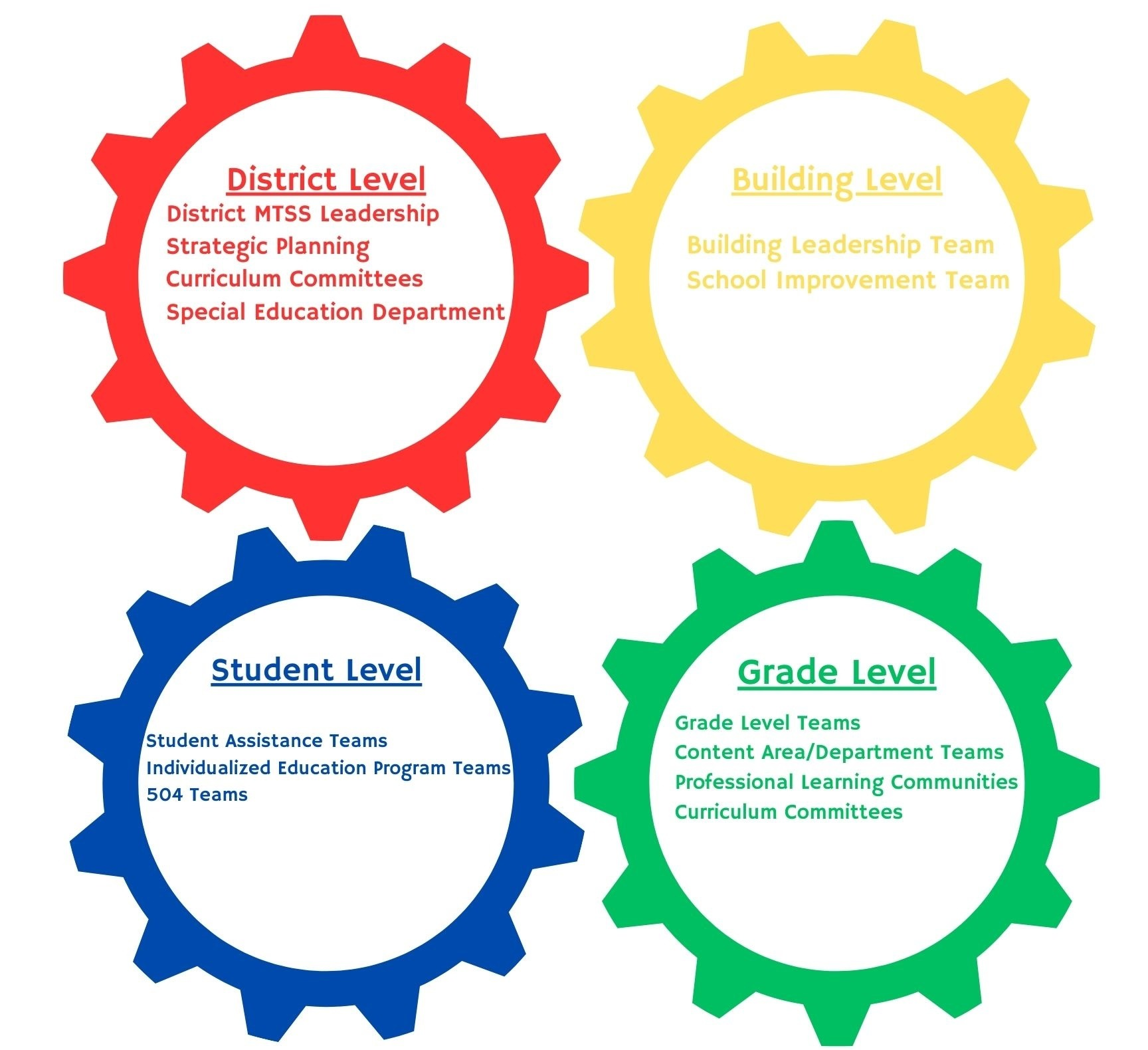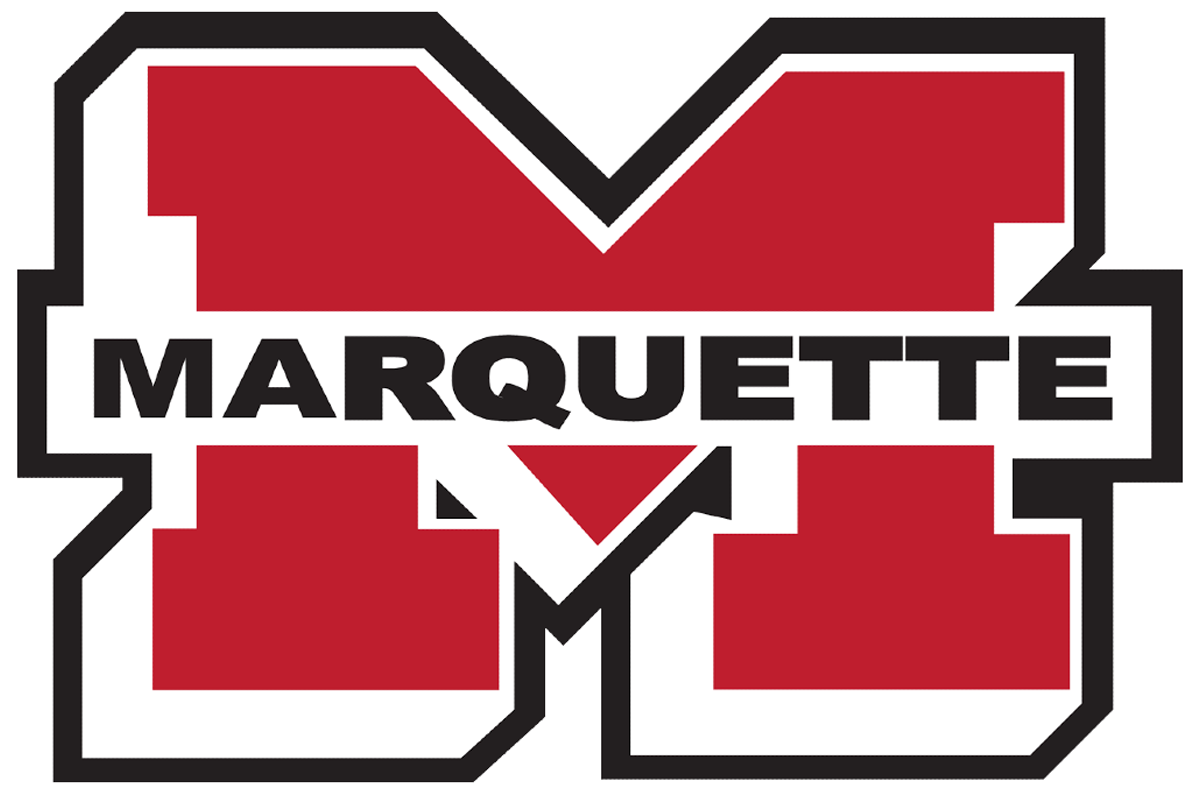Mechanisms for Implementation
District Leadership and Collaborative Teams
Successful implementation of the Multi-Tiered System of Supports requires robust teaming across and within a district and its schools. When teams function effectively in coordination with one another, they can meaningfully celebrate and leverage the collective wisdom and expertise of educators and educational partners to most effectively meet the needs of students.
Teaming is not just a structure—it is a mindset that fosters collaboration, shared accountability, and continuous improvement. Prioritizing teamwork within a district creates an environment where all students can thrive academically, socially, and emotionally.
Schedules
Careful attention to how time and resources are allocated is essential in the effective implementation of an MTSS framework. Schedules must allow for alignment between multi-layered practices and support the diverse needs of students, and take into account the demands on staff to consistently meet and perform their respective responsibilities.
MTSS is highly effective when integrated into a well-structured school schedule that allows for intervention, collaboration, and data-driven decision-making. This includes dedicated intervention blocks, tiered support integration, collaborative data meetings, professional learning community meetings, social-emotional learning and behavior supports, and Special Education and related services.
School Climate
School Climate is the quality and character of school life, particularly as it relates to patterns of students', caregivers', and school staff members’ experiences. School climate reflects norms, goals, values, interpersonal relationships, teaching and learning, leadership practices, and organizational structures anchored in culturally sustaining and linguistically responsive practices.
Professional Learning
Professional learning helps staff develop the skills and knowledge to improve student outcomes in social, emotional, behavioral, developmental, and academic areas. This learning, supported by instructional coaches throughout the district, ensures that educators continue to grow in their ability to use instructional practices and make decisions that are both culturally and linguistically sustaining.
A committee, in partnership with the superintendent and other key leaders, creates strategic professional development plans to support the implementation of MTSS.
Instructional Coaching
Instructional coaching is an evidence-based practice utilizing job-embedded professional development with the goal of improving instruction and student learning.
Vision for Instructional Coaching:
Instructional coaches are integral members of professional learning communities where:
Professional learning is directly embedded in daily, ongoing practices.
Student learning is the shared focus at all times.
Best practices are valued and consistently implemented.
Data is analyzed continuously and shared to inform instructional decisions.
Success is celebrated frequently.
Collaboration is a way of being.
WHAT COACHES DO
Collaborate
Co-plan
Co-teach
Model instructional practices
Observe student learning
Provide professional development
Facilitate team meetings
COACHING GOALS
Increase academic achievement and overall well-being of all students
Implement MTSS
Support job-embedded professional development
Increase teacher efficacy
Systemic Teams-Based Leadership

Roles and Responsibilities
District Level
Superintendent, Student Achievement Coordinator, Principal representation from each level, Special Education Director
Plan/Support the implementation of MTSS
Building Level
Principal, Instructional Coach, Title I Teacher, Special Education Teacher, Classroom Teacher, Specials Teacher, Support Staff, Parent
Discuss, vote upon, and change or adopt building-wide goals and policy
Recommend and engage in school improvement initiatives
Evaluate school-wide systems and work through data-based decision-making
Strategic Planning
Wellness, Business/Finance, Facilities, Student Achievement, Professional Development, Community Relations
These teams work in collaboration with the Superintendent to carry out the goals of the district within their specific areas of responsibility.
Grade Level
Grade Level teachers, Departments, Title I Team, Instructional Coach, Resource Room teachers, Speech and Language Pathologist, Principal
Meet 3-5 times/year to evaluate multiple sources of data to inform decisions about content, instructional practices, student accommodations, and intervention strategies
Form intervention groups that may include levels of support for Tier 1, Tier 2 and/or Tier 3
Student Level
Student Assistance Team (SAT) meetings include the Title I Teacher, Instructional Coach, Classroom Teacher and Principal, Parent, School Counselor*, Speech and Language Pathologist*, and Resource Room Teacher* (as needed).
Process:
IDENTIFY - Data evaluation teams create intervention groups with targeted academic or behavioral skill goals for students falling below grade level expectations.
EVALUATE - School-wide universal Progress Monitoring is conducted, and data is collected bi-weekly in 6-week intervention cycles. Teams meet 3-5 times/year, and Professional Learning Communities meet bi-weekly to evaluate progress.
PROBLEM SOLVE - When a student is not responding to targeted and intensified intervention strategies, the team determines that a SAT Meeting is necessary to develop further strategies to improve student outcomes.
IMPLEMENT & RE-EVALUATE - The team will implement strategies, progress will continue to be monitored in 6-week intervention cycles, and data will be regularly evaluated by the team.
Individualized Education Program Teams
Includes parents, student, general education teacher, special education teacher, related service providers (Occupational Therapy, Physical Therapy, Speech and Language Therapy, Social Work), consultants, and district representative.
Meet annually to address the needs of students with identified disabilities who meet Michigan criteria for special education services related to goals, accommodations, and services.
Monitor student progress data related to identified goals.
Provide targeted interventions to identified students.
504 Teams
Includes parents, student, general education teacher, counselor, related service providers (Occupational Therapist, Physical Therapist, Speech and Language Therapist, Social Work), and district representatives.
Meet annually to address the needs of students with documented disabilities related to accommodations and services.
Curriculum Committees
Plan/Support the implementation of MTSS
Work with colleagues and the administration to establish gaps and goals for improved student achievement. Coordinate with the administration and teachers for the review, analysis, and evaluation of the curriculum
Make recommendations for the adoption of curriculum resources
Establish a system for curriculum transparency (curriculum maps, etc.)
School Improvement Team
Improvement of school climate and culture
Professional Learning Communities (PLCs)
Grade-level teachers, departments, and the Instructional Coach
Work focused on improving instructional practice with the ultimate goal of increasing student achievement for all students
Plan instructional coaching cycles and lesson plans with Instructional Coaches
Work with cross-curricular teams to plan instruction
Discuss curriculum framework and updates from curriculum committees
Grading and Assessment
Early Warning System
Data-driven decision making
Curriculum Committees
Use data to find instructional/resource gaps
Use research to select resources for piloting
Implement a new instructional resource
Monitor the process
